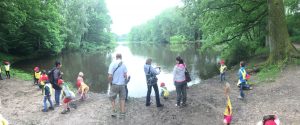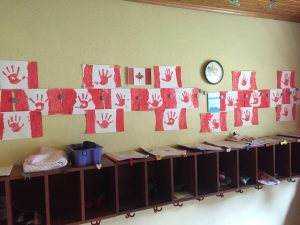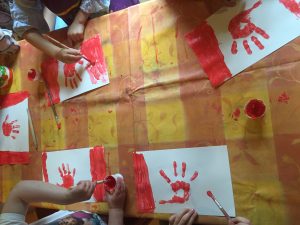
I was bitten by the travel bug early on in my life. I love to explore new cultures, customs, people and places. At the beginning of this school year, I was given the opportunity to participate in a self-placed community field experience (CFE). I thought long and hard about where I wanted to go, and what sort of education I wanted to experience. I finally settled on traveling to Hamburg, Germany to work in a kindergarten for two weeks. Germany’s educational system is quite different from the one I have experienced in Canada. Kindergarten in Germany appealed to me mainly because of their philosophies; children learn through exploration, play and personal experience. This idea matches very well with my inquiry topic, so I thought I would love to experience how it is done first hand.
I am now working in an english kindergarten where students are immersed in the english language beginning at age three and a half until they attend first grade at age six. The focus here is pushed towards socialization, problem solving, place based learning and of course, language immersion. The days consist of lots of play, students might choose to play alone on activities geared towards critical thinking and problem solving, or with others, working on socialization and managing confrontations that might arise. From what I have observed this far, the students are all very well adjusted to working with others. A few things that are emphasized are: being good community members, being polite and well mannered, turn taking, and other behavioural topics. When I arrived, each of the students introduced themselves to me as an adult might, looking me in the eyes and saying “Hello, my name is ____”.

The day begins with everyone eating breakfast together, followed by a morning meeting, where we go over colours, days of the week, weather and anything the students would like to share. Students then go off and play either outside on a nice day, or inside. Throughout the day, students are brought in to do some pedagogical work (more the 5-6 year old students). Working on math, social responsibilities and problem solving. There is a strong Montessori approach to education here, lots of hands on learning and problem solving. Students will then eat lunch  together, followed by more play time. Most days, there is some sort of special activity, twice a week, someone comes in and does music with them, once a week, they go to the local swimming pool and take swimming lessons, and then other activities are planned. This past week, we took all 25 students on the bus and the train to a forest to experience and learn about nature. We then went to a local outdoor market and ordered lunch before once again, taking the bus and train back to school. On Mondays, students are taken to a local gymnasium for physical activity. As far as I can tell, children do not attend traditional schools until grade one; kindergartens remind me of what North American’s would consider day care.
together, followed by more play time. Most days, there is some sort of special activity, twice a week, someone comes in and does music with them, once a week, they go to the local swimming pool and take swimming lessons, and then other activities are planned. This past week, we took all 25 students on the bus and the train to a forest to experience and learn about nature. We then went to a local outdoor market and ordered lunch before once again, taking the bus and train back to school. On Mondays, students are taken to a local gymnasium for physical activity. As far as I can tell, children do not attend traditional schools until grade one; kindergartens remind me of what North American’s would consider day care.

The students have been learning about countries around the world, and I am looking forward to teaming up with another teacher at the school who is from the USA to teach them about North America, I will discuss Canada and she will talk about the United States. They have just finished learning about India and are also going to be looking at China. Not only are these students learning a second language, they are interested and excited to learn about the world. They are given a concept of other cultures and ways of thinking, which I think will aid them in their curiosities for learning in the future.
I have really enjoyed my first week in a German kindergarten, I am noticing lots of differences in the practices and approaches to education.





 together, followed by more play time. Most days, there is some sort of special activity, twice a week, someone comes in and does music with them, once a week, they go to the local swimming pool and take swimming lessons, and then other activities are planned. This past week, we took all 25 students on the bus and the train to a forest to experience and learn about nature. We then went to a local outdoor market and ordered lunch before once again, taking the bus and train back to school. On Mondays, students are taken to a local gymnasium for physical activity. As far as I can tell, children do not attend traditional schools until grade one; kindergartens remind me of what North American’s would consider day care.
together, followed by more play time. Most days, there is some sort of special activity, twice a week, someone comes in and does music with them, once a week, they go to the local swimming pool and take swimming lessons, and then other activities are planned. This past week, we took all 25 students on the bus and the train to a forest to experience and learn about nature. We then went to a local outdoor market and ordered lunch before once again, taking the bus and train back to school. On Mondays, students are taken to a local gymnasium for physical activity. As far as I can tell, children do not attend traditional schools until grade one; kindergartens remind me of what North American’s would consider day care.
 flipping the lights off and saying “hands on top, everybody stop”. I need to broaden my teaching abilities. I am a TC who works with early primary aged students, and this may not be where I end up. I need to remember that, one day I may work with middle years students, and to do this I need a few more tools in my toolbox. I also need to learn to let students be independent when and if they are able. Teaching students who can work independently can call for initial
flipping the lights off and saying “hands on top, everybody stop”. I need to broaden my teaching abilities. I am a TC who works with early primary aged students, and this may not be where I end up. I need to remember that, one day I may work with middle years students, and to do this I need a few more tools in my toolbox. I also need to learn to let students be independent when and if they are able. Teaching students who can work independently can call for initial